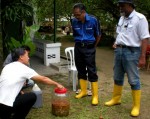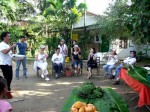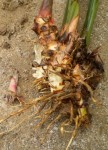Apr 27, 2009
No-Dig Herb And Vegetable Garden - Report No. 2
The No-Dig, Lazy-Man herb and vegetable gardens are turning out very well. The plants are luxuriant and really a joy to behold in the mornings with their fragrances and buzy insects. Part of the reason is the use of our "Qi Compost" which seems especially well suited to herbs and the slower growing varieties of vegetables. There's so little work involved in maintaining the gardens, it's amazing!


Here are some of the herbs and vegetables growing at the lazy-man's gardens:


18:38 Posted in Permaculture | Permalink | Comments (0) | Tags: permaculture, no-dig garden, lazy-man garden
Apr 19, 2009
Rare Receipes - Durian Flowers
 Durian flowers are delicious with a subtle taste and smell. It can be eaten raw as a salad with some sambal belacan. When eaten raw, the whole flower can be eaten - the petals, stamen, pistil and sepal. The sepal is sweet with a tinge of bitterness.
Durian flowers are delicious with a subtle taste and smell. It can be eaten raw as a salad with some sambal belacan. When eaten raw, the whole flower can be eaten - the petals, stamen, pistil and sepal. The sepal is sweet with a tinge of bitterness.
The flowers are delicious stir-fried with prawns, calamari, or shell fish , with chicken pieces, with tofu. When stir-frying, use only the petals, stamen and pistil. Do not use the sepal which turns acrid when heated.
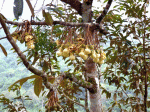
Make sure you get your flowers from an organic farm such as DQ Farm as during flowering season conventional farms will use a fair bit of weedicide and fungicide.


Parts of the durian flower. The sepal is sweet when eaten raw but turns acrid when cooked.
Simple Yet Delicious
Quickly immersed flowers in boiling water, remove and drain. When cool, serve with sambal belacan.
Stir-fried with Calamari - spicy
Blend onions, garlic and fresh red chillies. Stir-fry in some oil until fragrant. Add prawns or calamari, salt and some sugar to taste. If desired some belacan can be added. Add flowers for a few quick stirs, and serve. Yummy.
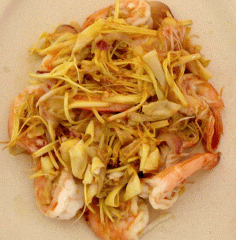 Stir-fried with Prawns
Stir-fried with Prawns
Chop onions and garlic. Stir-fry until fragrant. Add prawns, salt and sugar. Add flowers, stir fry quickly, serve. For those prefering a bit of spiciness, add chopped chilli padi as garnish.
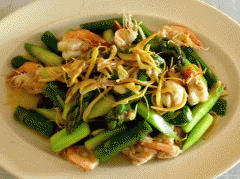
Stir-fried asparagus with prawns, oyster sauce and of course, durian flowers.
20:53 Posted in Slow Food / Rare Receipes | Permalink | Comments (0) | Tags: durian, flowers, slow food, rare receipes
Apr 17, 2009
Rare Receipes - Lontong Daun Pisang Sematu

'LONTONG' done traditionally is rarely found nowadays; at least in the cities. Some people are using plastic bags and green coloring! Before the traditional way is lost forever, here's the method:
Use only leaves from the banana plant called 'sematu' or 'batu' or 'nipah'. Using leaves from this banana cultivar will impart a deep green color to the rice and a wonderful fragrance. Leaves from other banana cultivars can be used but the color will be lacking, and the aroma is not as fragrant. Try to get leaves from an organic farm as fungicides are used extensively in banana cultivation especially if they are using tissue-cultured clones.

The 'sematu' fruit is mottled, untidy and is 3-sided and angled.
The 'sematu' banana plant is tall, at our farm it reaches to 20 feet high. We grow the plant to provide shade for the chickens in the fields. The fruit tastes better fried or cooked and is seldom eaten raw.

The 'heart' or male flower of the 'sematu' at our farm is big, easily 18 inches long.
Use 2 or 3 layers of the leaves. Use a narrow cylinder as a mould and roll the leaves. Make sure the overlap errs on the generous side so that the expanding rice will not cause the ends of the leaves to open up. Remove the mould. Close one end of the rolled leaves with tooth picks or if you intend to keep the lontong for a few days, stitch it up. This is to prevent the rice during storage, from going moldy by exposure to air.
This is to prevent the rice during storage, from going moldy by exposure to air.
The 'sematu' leaf gives a rich green color to the cooked rice which should be glutinous-like after cooking and no longer seperates into individual grains.
Fill the rolled leaves to 30% to 40% of its length with rice. You may have to try out one cylinder first as different rice have different expansion rates. You want the rice to expand and get 'compressed' within the rolled leaves. Secure the other end.
Put the rolls into a stainless steel pot and boil for 3 to 4 hours. Do not use an aluminum pot as the greenish color will be faint due to some reaction with the leached aluminum. Take out the lontong and let drain. After it has cooled, serve. Kept in a cool dry place, it can keep for 3 days. Kept in the refrigerator it can keep for up to 10 days.
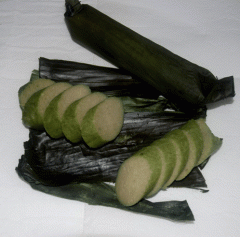
Serve with curries, with rendang, or with Chinese stews, for example those with chicken or goat pieces stewed with black soya sauce, mushrooms, garlic and herbs. Another interesting dish is lontong with grated coconut and gula melaka or palm sugar.
22:27 Posted in Slow Food / Rare Receipes | Permalink | Comments (0) | Tags: slow food, lontong, pisang sematu, pisang batu, pisang nipah
Apr 13, 2009
Farm Visit - Head of Veterinary Services and Country Farm
Datuk Dr. Azahar Idris, the Director of Veterinary Services for Pahang dropped by on a surprise visit. Here he is shown how composted chicken litter can be used as a planting medium and as fertiliser.
Nothing is wasted in DQ Farm, carcasses, litter, etc are all recycled to produce healthy vegetables, fruits and herbs.
Sorry Datuk, no exceptions! All visitors have to smell this 7 year old litter.
And from the herb garden, a fermented mix as a preventive and tonic for the chickens.
Yesterday, April 12, Selina Gan, MD of Country Farm came visiting with her family and senior staff.
Overview of a sustainable farm - 1 + 1 = 10!

They were expecting some foul smell from the carcasses, dung, and stuff.
Taking back bags of charcoal to fertilise their home gardens, and to bury some carbon!
20:53 Posted in Visitors | Permalink | Comments (0) | Tags: veterinary services, country farm, farm visits
Apr 10, 2009
Useful Plants At The Farm- Galangal or Alpinia Galanga / Greater Galanga
The Greater Galanga or lengkuas is a ginger originally from Malaysia and Indonesia. It is used in Thai, Malay, Nyonya and Indonesian cuisine.
It is active against gram-positive and gram-negative bacteria.
In our farm, we have found it to be effective against mycoplasma sp. infection in the chickens. In combination with garlic and at the appropriate dosage it is effective against chronic infections.
We now use lengkuas as a weekly preventive for the chickens
At our farm, we grow the lengkuas wild in our Food Forest. It requires no maintenance and provides free medicine for our animals and even our workers.
Here’s more information about lengkuas:
http://en.wikipedia.org/wiki/Greater_galangal
You can learn a saying or two about lengkuas here:
17:30 Posted in Useful Plants | Permalink | Comments (2) | Tags: galangal, alpinia galanga, greater galanga, lengkuas, lankwas, laos, food forest, permaculture
Apr 08, 2009
Earthworms - Count 'Em, Jimmy Loke
Jimmy Loke, a gentleman farmer came visiting and expressed the hope that I can share more knowledge with him and his brother. Well, the first thing is, count the earthworms in your farm, Jimmy.
Early in the morning, when the earthworms come out to feed, count them.
Mark out a foot square.
Dig out the foot cube of soil. Do it fast as earthworms are sensitive to vibrations and many will make off.
Count 'em.
In DQ Farm, we have up to 60 earthworms per cubic foot of soil. On a good day, it can reach 100. In some Western countries they are happy with 10 - 15.
And here in Malaysia, with such good soil, we are dumping synthetic fertilisers and stuff to kill them off.
So Jimmy, count your earthworms, and if they are lacking, build them up to at least 40 before we talk about organic farming.
20:04 Posted in Blog | Permalink | Comments (0) | Tags: earthworms, organic farming
Apr 06, 2009
Farm Visit - Nutriheal, Kota Kemuning
Nutriheal, an organic shop in Kota Kemuning organised for some of their customers to come to the farm for a visit yesterday, April 5th.
We were a little upset to see so many children, as DQ Farm is a working farm and we do not run a seperate "demo" farm. What-You-See-Is-What-You-Get. In our farm, you are going to have weaver ants (Oecophylla smaragdina) , bees, killer wasps, 7 inches centipedes and cobras to name a few of the worries we have with kids around.
Weaver ants build huge nests the size of footballs in our durian trees. We do not get rid of them as they protect our fruits from insect and animal damage. But on occasion, a huge nest will just drop down for no reason whatsoever, and if it were to land on a kid...!
On top of that, we are continously running our retort to make biochar and I shudder to think what will happen if a kid were to place his palm on the 400 degree celcius surface of the retort.
We hope future visitors follow our instructions strictly and not bring kids. It is just too dangerous!
18:20 Posted in Visitors | Permalink | Comments (2) | Tags: nutriheal, farm visits
Apr 04, 2009
Useful Plants At The Farm- Derris elliptica or Tuba
Tuba root has long been used by the ‘Orang Asli’ to fish, as it is a piscicide.

As we can see from the pictures, the plant has arresting flowers.
It is a creeping and climbing vine.
It is a wasteful method of fishing as all fish, big or small are wiped out within minutes. Thankfully, very few ‘Orang Asli’ are using tuba roots nowadays and in fact, some do not even know how to identify it.
The root of the tuba.
In the farm we grow it for use as an insecticide. It is the only local plant that we know of, that’s truely insecticidal. The rest are repellents. For many years, organic standards permitted the use of rotenone, the active ingredient in tuba root against insects. That has now been withdrawn.
Pounding the root.
We do not use tuba on vegetables or fruits, but on roots and trunks of non-fruiting trees and ornamentals that are attacked by tough borers etc. The withdrawal of its use in organic farms is because of concern over its safety after scientists injected the active ingredient, rotenone, into the blood stream of rats and which resulted in Parkinson’s-like symptoms in the rats.
The pounded root will be squeezed in water to make an aqueous extract of the active ingredient, rotenone.
The milky aqueous extract ready for use.
Quote from Wikipedia, “In 2000 it was reported that injecting rotenone into rats causes symptoms of Parkinson's disease to develop. Rotenone was continuously applied over a period of five weeks, mixed with DMSO and PEG to enhance tissue penetration, and injected into the jugular vein.[12] “ . Citation [12] here refers to : Caboni P, Sherer T, Zhang N, Taylor G, Na H, Greenamyre J, Casida J (2004). "Rotenone, deguelin, their metabolites, and the rat model of Parkinson's disease". Chem Res Toxicol 17 (11): 1540–8.
One would think that would be expected injecting toxic stuff into the bloodstream. Anyway, as an organic farmer, it is better to be on the safe side and cease from using tuba on edibles. The tuba extract does not remain in the environment and is totally detoxifed in 6 to 7 days, being degraded by sunlight.
In the farm, though rarely used, it is nonetheless a useful plant to have.
18:45 Posted in Useful Plants | Permalink | Comments (5) | Tags: derris, tuba, fish poison, piscicide, organic insecticide, tuba root, akar tuba
Mar 15, 2009
Farm Visit March 15, 2009
Retailers and customers of DQ Chicken came to the farm today to see for themselves how the farm is managed, and the farming methods used.


The herb spiral drew interest


For the priviledge of visiting the farm, you have to smell this compost made of dung, carcasses and dried leaves and branches.
You also have to smell a still used chicken litter that has not been removed for 7 years, from one of the coops.

Feeling the Qi

Looking for Qi
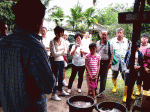
Qi Tea for spraying on plants


High productivity aquaculture - one tiny pond such as this can fetch a revenue of RM10,000 per cycle of 6 months.

Then fruits from the farm for everybody.
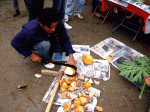
Coconuts to quench your thirst after a hot day walking around.

Here's a straw from a papaya leaf stem to drink your coconut water with.

Yummy, perfect end to a hot day.
18:53 Posted in Visitors | Permalink | Comments (2) | Tags: sustainable farming, organic farming, farm visits, nature farming
Mar 14, 2009
Mandala, Bird's Nest and Snake-Shaped Pond
Mandala Garden and Bird's Nests
The twain can meet. Here's how:
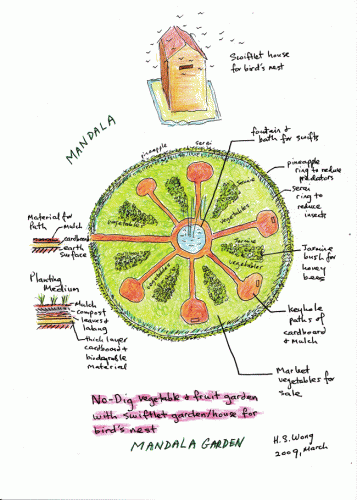
I intend to build this at the farm. The mandala shall be 40 ft across. Swifts need a roving area in front and a large water source, and that will be the mandala's centre.
The animals produce lots of gnats and mosquitoes during the wet season and swifts eat them, thus doing the farm a service.
The mandala in front will provide a conducive environment for the swifts and enhance production of the edible nests. One house will produce up to 40 kg of nests; selling for rm4,000 per kg, that's rm160,000 per house per annum.
Semi-Intensive Snake-Shaped Fish Pond
Commercial fish ponds pollute the environment and are energy intensive. Because of intensive farming, the ponds use pumps and motors to aerate. Waste are typically just discharged to the environment.

This snake shape pond will use gravity to flow the water from Point A to Point B, from Point B a wind powered pump will lift up the water to the filtration pond which shall comprise mechanical and biological filtration to clean the water. Throughout the length of the snake-shaped pond will be surface disruptors to aerate, as the water gravity-flows throughout the length of the pond.
My bank which advertises that they are 'friends' of farmers told me my mandala and bird's nest, and snake-shaped pond, is not agriculture, it's hobby farming!
Looks like I have to sell off some asset to fund these ideas. Eco-solutions have to make financial sense for farmers to adopt them. I think these two ideas can produce good income without damaging the environment.
22:03 Posted in Permaculture | Permalink | Comments (7) | Tags: permaculture, mandala garden, no-dig garden, bird's nest, swiftlets, seriti, walet, aquaculture















